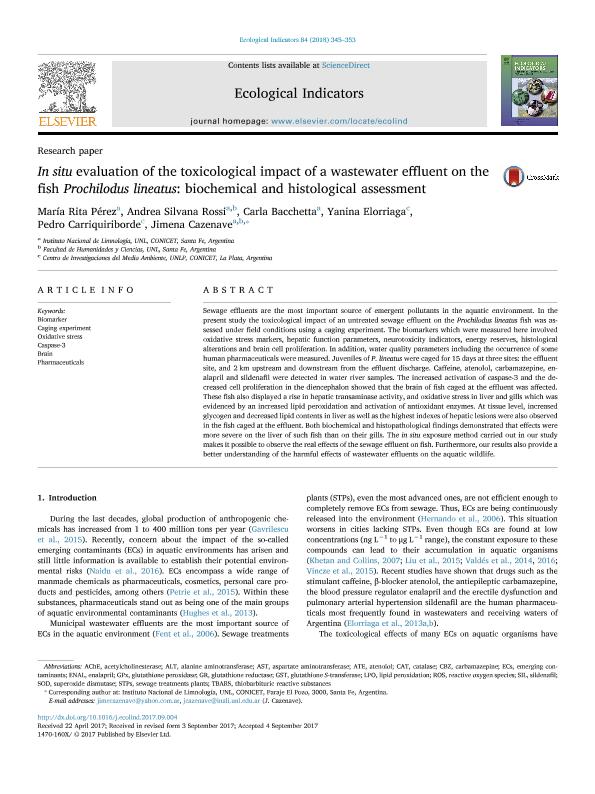Mostrar el registro sencillo del ítem
dc.contributor.author
Pérez, María Rita

dc.contributor.author
Rossi, Andrea Silvana

dc.contributor.author
Bacchetta, Carla

dc.contributor.author
Elorriaga, Yanina

dc.contributor.author
Carriquiriborde, Pedro

dc.contributor.author
Cazenave, Jimena

dc.date.available
2019-11-12T19:29:24Z
dc.date.issued
2018-01
dc.identifier.citation
Pérez, María Rita; Rossi, Andrea Silvana; Bacchetta, Carla; Elorriaga, Yanina; Carriquiriborde, Pedro; et al.; In situ evaluation of the toxicological impact of a wastewater effluent on the fish Prochilodus lineatus: biochemical and histological assessment; Elsevier Science; Ecological Indicators; 84; 1-2018; 345-353
dc.identifier.issn
1470-160X
dc.identifier.uri
http://hdl.handle.net/11336/88675
dc.description.abstract
Sewage effluents are the most important source of emergent pollutants in the aquatic environment. In thepresent study the toxicological impact of an untreated sewage effluent on the Prochilodus lineatus fish was assessedunder field conditions using a caging experiment. The biomarkers which were measured here involvedoxidative stress markers, hepatic function parameters, neurotoxicity indicators, energy reserves, histologicalalterations and brain cell proliferation. In addition, water quality parameters including the occurrence of somehuman pharmaceuticals were measured. Juveniles of P. lineatus were caged for 15 days at three sites: the effluentsite, and 2 km upstream and downstream from the effluent discharge. Caffeine, atenolol, carbamazepine, enalapriland sildenafil were detected in water river samples. The increased activation of caspase-3 and the decreasedcell proliferation in the diencephalon showed that the brain of fish caged at the effluent was affected.These fish also displayed a rise in hepatic transaminase activity, and oxidative stress in liver and gills which wasevidenced by an increased lipid peroxidation and activation of antioxidant enzymes. At tissue level, increasedglycogen and decreased lipid contents in liver as well as the highest indexes of hepatic lesions were also observedin the fish caged at the effluent. Both biochemical and histopathological findings demonstrated that effects weremore severe on the liver of such fish than on their gills. The in situ exposure method carried out in our studymakes it possible to observe the real effects of the sewage effluent on fish. Furthermore, our results also provide abetter understanding of the harmful effects of wastewater effluents on the aquatic wildlife.
dc.format
application/pdf
dc.language.iso
eng
dc.publisher
Elsevier Science

dc.rights
info:eu-repo/semantics/openAccess
dc.rights.uri
https://creativecommons.org/licenses/by-nc-nd/2.5/ar/
dc.subject
BIOMARKER
dc.subject
CAGING EXPERIMENT
dc.subject
OXIDATIVE STRESS
dc.subject
CASPASE 3
dc.subject.classification
Biología Marina, Limnología

dc.subject.classification
Ciencias Biológicas

dc.subject.classification
CIENCIAS NATURALES Y EXACTAS

dc.title
In situ evaluation of the toxicological impact of a wastewater effluent on the fish Prochilodus lineatus: biochemical and histological assessment
dc.type
info:eu-repo/semantics/article
dc.type
info:ar-repo/semantics/artículo
dc.type
info:eu-repo/semantics/publishedVersion
dc.date.updated
2019-10-23T21:36:35Z
dc.journal.volume
84
dc.journal.pagination
345-353
dc.journal.pais
Países Bajos

dc.journal.ciudad
Amsterdam
dc.description.fil
Fil: Pérez, María Rita. Consejo Nacional de Investigaciones Científicas y Técnicas. Centro Científico Tecnológico Conicet - Santa Fe. Instituto Nacional de Limnología. Universidad Nacional del Litoral. Instituto Nacional de Limnología; Argentina
dc.description.fil
Fil: Rossi, Andrea Silvana. Consejo Nacional de Investigaciones Científicas y Técnicas. Centro Científico Tecnológico Conicet - Santa Fe. Instituto Nacional de Limnología. Universidad Nacional del Litoral. Instituto Nacional de Limnología; Argentina
dc.description.fil
Fil: Bacchetta, Carla. Consejo Nacional de Investigaciones Científicas y Técnicas. Centro Científico Tecnológico Conicet - Santa Fe. Instituto Nacional de Limnología. Universidad Nacional del Litoral. Instituto Nacional de Limnología; Argentina
dc.description.fil
Fil: Elorriaga, Yanina. Universidad Nacional de La Plata; Argentina
dc.description.fil
Fil: Carriquiriborde, Pedro. Universidad Nacional de La Plata; Argentina
dc.description.fil
Fil: Cazenave, Jimena. Consejo Nacional de Investigaciones Científicas y Técnicas. Centro Científico Tecnológico Conicet - Santa Fe. Instituto Nacional de Limnología. Universidad Nacional del Litoral. Instituto Nacional de Limnología; Argentina
dc.journal.title
Ecological Indicators

dc.relation.alternativeid
info:eu-repo/semantics/altIdentifier/url/http://linkinghub.elsevier.com/retrieve/pii/S1470160X17305666
dc.relation.alternativeid
info:eu-repo/semantics/altIdentifier/doi/http://dx.doi.org/10.1016/j.ecolind.2017.09.004
Archivos asociados
